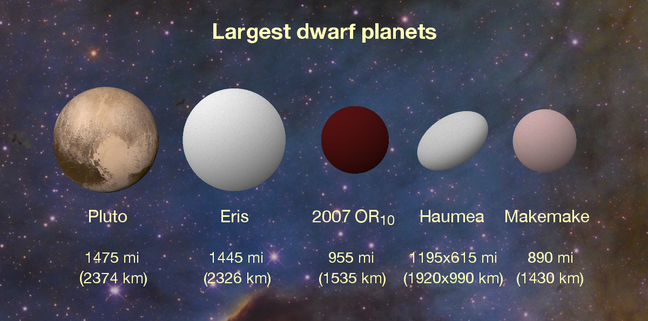This article is more than 1 year old
Dwarf planet intumesces before astronomers' gaze
Only Pluto and Eris larger than trans-Neptunian '2007 OR10'
Astronomers have used observations from the Kepler space telescope and the Herschel Space Observatory to determine that the trans-Neptunian object "2007 OR10" is bigger than previously thought, and now ranks third in the solar system's dwarf planet size league table, behind Pluto and Eris.
The distant body was first spied back in 2007, as its provisional name indicates, by skygazers Mike Brown, David Rabinowitz and Meg Schwamb during "a survey to search for distant solar system bodies using the Samuel Oschin Telescope at Palomar Observatory near San Diego, California", as NASA puts it.
While initial data from Herschel alone indicated a diameter of around 1,280 kilometers (795 miles), scientists needed to determine 2007 OR10's rotational period "to estimate its overall brightness, and hence its size".
Bringing Kepler into play provided the necessary info for an investigative team led by András Pál of the Konkoly Observatory in Budapest. NASA elaborates: "Together, the two space telescopes allowed the team to measure the fraction of sunlight reflected by 2007 OR10 (using Kepler) and the fraction absorbed and later radiated back as heat (using Herschel). Putting these two data sets together provided an unambiguous estimation of the dwarf planet's size and how reflective it is."

The dwarf planet league table. Pic: Konkoly Observatory/András Pál, Hungarian Astronomical Association/Iván Éder, NASA/JHUAPL/SwRI
The result is a diameter of 1,535 kilometres (955 miles), around a third smaller than Pluto but outbulking the next-largest dwarf, Makemake, by 100 kilometres.*
The embiggenment is significant because it suggests that 2007 OR10's previously-identified dark red hue may be the result of surface "volatile ices of methane, carbon monoxide and nitrogen, which would be easily lost to space by a smaller object", according to András Pál.
He enthused: "It's thrilling to tease out details like this about a distant, new world - especially since it has such an exceptionally dark and reddish surface for its size."
The discoverers of 2007 OR10 feel the time has now arrived to christen their baby with an appropriate moniker. Meg Schwamb said: "The names of Pluto-sized bodies each tell a story about the characteristics of their respective objects. In the past, we haven't known enough about 2007 OR10 to give it a name that would do it justice. I think we're coming to a point where we can give 2007 OR10 its rightful name."
No doubt readers have plenty of suggestions. ®
Bootnote
*In terms of average diameter. Haumea, as you can see in the above graphic, is a 1,920 by 990km space sausage.
